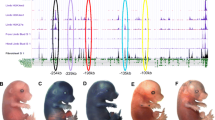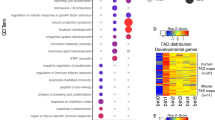Abstract
Development of a multicellular organism is critically dependent on the proper temporal and spatial cues that regulate gene expression. Thus, in any one cell at a particular time, only a subset of the total genetic information is expressed. Manifestation of a gene’s function is a multistep process that starts at the chromosome of a cell in the form of transcription and ends at the production of a functional protein in the proper place and time. Thus, regulation can be applied at numerous points in this pathway. The early step of transcription initiation represents one of such points of control. Typically, the regulatory elements that are responsible for directing specific transcription initiation reside within the 5′ promoter region of the gene. The elucidation of the mechanisms how different promoter sequences generate tissue-specific gene expression will be invaluable to our understanding of how transcription may be modulated during development.
Access this chapter
Tax calculation will be finalised at checkout
Purchases are for personal use only
Preview
Unable to display preview. Download preview PDF.
Similar content being viewed by others
References
Assaad FF, Signer ER (1990) Cauliflower mosaic virus P35S promoter activity in Escherichia coli. Mol Gen Genet 223: 517–520
Benfey PN, Chua NH (1990) The cauliflower mosaic virus 35S promoter: Combinatorial regulation of transcription in plants. Science 250: 959–966
Benfey PN, Ren L, Chua NH (1989) The CaMV 35S enhancer contains at least two domains which can confer different developmental and tissue-specific expression patterns. EMBO J 8: 2195–2202
Crenshaw III EB, Kalla K, Simmons DM, Swanson LW, Rosenfeld MG (1989) Cell-specific expression of the prolactin gene in transgenic mice is controlled by synergistic interactions between promoter and enhancer elements. Genes Dev 3: 959–972
Fang RX, Nagy F, Sivasubramaniam S, Chua NH (1989) Multiple cis regulatory elements for maximal expression of the cauliflower mosaic virus 35S promoter in transgenic plants. Plant Cell 1: 141–150
Fromental C, Kanno M, Nomiyama H, Chambon P (1989) Cooperativity and hierarchical levels of functional organization in the SV40 enhancer. Cell 54: 943–953
Fromm M, Taylor LP, Walbot V (1985) Expression of genes transferred into monocot and dicot plant cells by electroporation. Proc Natl Acad Sci USA 82: 5824–5828
Green PJ, Yong MH, Cuozzo M, Kano-Murakami Y, Silverstein P, Chua NH (1988) Binding site requirements for pea nuclear protein factor GT-1 correlate with sequences required for light-dependent transcriptional activation of the rbcS-3A gene. EMBO J 7: 4035–4044
Harpster MH, Townsend JA, Jones JDG, Bedbrook J, Dunsmuir P (1988) Relative strengths of the 35S califlower mosaic virus, 1’, 2’ and nopaline synthase promoters in transformed tobacco sugarbeet and oilseed rape callus tissue. Mol Gen Genet 212: 182–190
Katagiri F, Lam E, Chua NH (1989) Two tobacco DNA-binding proteins with homology to the nuclear factor CREB. Nature 340: 727–730
Kuhlemeier C, Cuozzo M, Green PJ, Goyvaerts E, Ward K, Chua NH (1988) Localization and conditional redundancy of regulatory elements in rbcS-3A, a pea gene encoding the small subunit of the ribulose-bisphosphate carboxylase. Proc Natl Acad Sci USA 85: 4662–4666
Lam E, Chua NH (1989) ASF-2: A factor that binds to the cauliflower mosaic virus 35S promoter and a conserved GATA motif in cab promoters. Plant Cell 1: 1147–1156
Lam E, Chua NH (1990) GT-1 binding site confers light responsive expression in transgenic tobacco. Science 248: 471–474
Lam E, Benfey PN, Gilmartin PM, Fang RX, Chua NH (1989a) Site-specific mutations alter in vitro factor binding and change promoter expression pattern in transgenic plants. Proc Natl Acad Sci USA 86: 7890–7894
Lam E, Benfey PN, Chua NH (1989b) Characterization of AS-1: a factor binding iste on the 35S promoter of cauliflower mosaic virus. In: Lamb C, Beachy R (eds) Plant gene transfer. UCLA Symp on Molecular and cellular biology, new series, vol 129. Academic Press, New York, pp 71–79
Odell JT, Nagy F, Chua NH (1985) Identification of DNA sequences reqired for activity of the cauliflower mosaic virus 35S promoter. Nature 313: 810–812
Odell JT, Knowlton S, Lin W, Mauvais JC (1988) Properties of an isolated transcription stimulating sequence derived from the cauliflower mosaic virus 35S promoter. Plant Mol Biol 10: 263–272
Ondek B, Shepard A, Herr W (1987) Discrete elements within the SV40 enhancer region display different cell-specific enhancer activities. EMBO J 6: 1017–1025
Ondek B, Gloss L, Herr W (1988) The SV40 enhancer contains two distinct levels of organization. Nature 333: 40–45
Ow DW, Jacobs JD, Howell SH (1987) Functional regions of the cauliflower mosaic virus 35S RNA promoter determined by use of the firefly luciferase gene as a reporter of promoter activity. Proc Natl Acad Sci USA 84: 4870–4874
Pobjecky N, Rosenberg GH, Dinter-Gottlieb G, Kaufer NF (1990) Expression of the ß-glucuronidase gene under the control of the CaMV 35S promoter in Schizosaccharomyces pombe. Mol Gen Genet 220: 314–316
Poulsen C, Chua NH (1988) Dissection of 5’ upstream sequences for selective expression of Nicotiana plumbaginifolia rbcS-8B gene. Mol Gen Genet 214: 16–23
Sanders PR, Winter JA, Barnason AR, Rogers SG, Fraley RT (1987) Comparison of cauliflower mosaic virus 35S and nopaline synthase promoters in transgenic plants. Nucleic Acids Res 15: 1543–1558
Schirm S, Jiricny J, Schaffner W (1987) The SV40 enhancer can be dissected into multiple segments, each with a different cell type specificity. Genes Dev 1: 65–74
Yanagisawa S, Izui K (1992) MNF1, a leaf tissue-specific DNA-binding protein of maize, interacts with the cauliflower mosaic virus 35S promoter as well as the C4 photosynthetic phosphoenolpyruvate carboxylase gene promoter. Plant Mol Biol 19: 545–553
Author information
Authors and Affiliations
Editor information
Editors and Affiliations
Rights and permissions
Copyright information
© 1994 Springer-Verlag Berlin Heidelberg
About this paper
Cite this paper
Lam, E. (1994). Analysis of Tissue-Specific Elements in the CaMV 35S Promoter. In: Nover, L. (eds) Plant Promoters and Transcription Factors. Results and Problems in Cell Differentiation, vol 20. Springer, Berlin, Heidelberg. https://doi.org/10.1007/978-3-540-48037-2_8
Download citation
DOI: https://doi.org/10.1007/978-3-540-48037-2_8
Publisher Name: Springer, Berlin, Heidelberg
Print ISBN: 978-3-662-22304-8
Online ISBN: 978-3-540-48037-2
eBook Packages: Springer Book Archive




